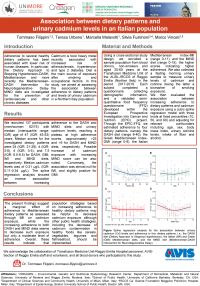Abstract
Introduction: Adherence to several healthy dietary patterns has been associated with lower risk of human diseases. In particular, the Dietary Approach to Stopping Hypertension-DASH, Mediterranean and more recently the Mediterranean-DASH Intervention for Neurodegenerative Delay-MIND diets are investigated for the prevention of cardiovascular and other chronic diseases. Cadmium is toxic heavy metal recently associated with increased risk of atherosclerosis, hypertension and type 2 diabetes. Diet is the main source of exposure after smoking and occupational factors. In this study, we aimed at assessing the association between adherence to dietary patterns and levels of urinary cadmium in a Northern Italy population.
Material and Methods: Using a cross-sectional study design, we recruited a sample population from blood donors, non-smokers and aged 30-60 years at the Transfusion Medicine Unit of the AUSL-IRCCS of Reggio Emilia (Norther Italy) in the period 2017-2019. Each subject completed a questionnaire collecting demographic information, and a validated semi-quantitative food frequency questionnaire (FFQ) developed within the European Prospective Investigation into Cancer and nutrition (EPIC) project. Through the EPIC-FFQ, we estimated adherence to four dietary patterns, namely the DASH diet (range 8-40), the Greek Mediterranean Index-GMI (range 0-9), the Italian Mediterranean Index-IMI (range 0-11), and the MIND diet (range 0-15), the higher scores indicating higher adherence. We also collected a fasting morning urinary sample to measure urinary levels of cadmium and cotinine (being the latter a biomarker of smoking exposure).
We then evaluated the association between increasing adherence to dietary patterns and cadmium exposure using a cubic spline regression model with three knots at fixed percentiles (10, 50, and 90) and adjusting for relevant confounders including age, sex, body mass index, urinary cotinine levels, intake of fiber and alcohol.
Results: We recruited 137 participants (men/women: 62/75) with median (interquartile range-IQR) age of 47 (IQR: 43-53) years. Median scores for the investigated dietary patterns were 24 (IQR: 21-28), 4 (IQR: 3-6), 4 (IQR: 3-5), and 7.5 (IQR: 6.5-8.5) for DASH, GMI, IMI and MIND diets, respectively. Median cadmium levels was of 0.21 mcg/L (IQR: 0.11-0.34 mcg/L). The spline regression analysis showed an inverse association between increasing adherence to the DASH and MIND diets and urinary cadmium levels, reaching a plateau at high adherence scores, approximately >25 and >9 for DASH and MIND diets, respectively. Possible increase of cadmium exposure with increasing MIND score can be also noted. Conversely, the association was almost null for IMI, and slightly positive for GMI.
Conclusion: The present findings suggest a marginal effect of adherence to Mediterranean dietary patterns as assessed through IMI on cadmium exposure, while the increasing adherence to both DASH and MIND diets seems to decrease such exposure but only a moderate level of adherence. Overall, these results indicate that population strategies based on increasing adherence to healthy dietary patterns may be helpful to decrease cadmium exposure, although other public health strategies, including the decrease of cadmium contamination in healthy foods like cereals, vegetables, legumes and fish/seafood, should be implemented.

